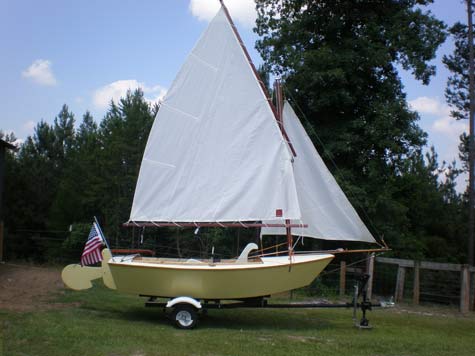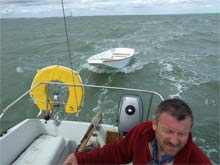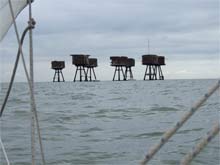|
|
| This time we have the following boats:
Send a picture or three and a short description of your boat and its launch
to chuck.leinweber@gmail.com for inclusion here next month.
|
SF Pelican
Well here are the sails from Duckworks - they are beautiful, and I thank you very much. I wanted to get a picture of the first sail but not sure when that will happen kinda busy, but the sails look great and the 12' SF Pelican designed by CPT William H Short is a beautiful boat, I can only hope that I have done his design justice and hope to have many years of family fun.

|
Nymph
Chuck,
Here are a few photos of my Nymph with the Tender Behind sail as you requested. I’m still experimenting with the rigging, since this is my first lug rigged sail. The mast as shown is a little too short, so I’ve started making another one. However, the first sail in light winds was very nice. The rig is well balanced and has a slight weather helm. The third picture is one of my two grandsons who “helped” with the construction.
Terry Green
|
Toto
Chuck,
Attached are some pictures of a Toto that I recently finished for my wife. All the supplies execpt for ply and paint were from Duckworks. It is 6mm Okume covered inside and out with 6 oz glass set in epoxy.
Thanks for all you do.
Barry White
|
 |
Phoenix III
Dear Ross:
Your website looks better than ever. The Periwinkle is gorgeous. Thought you might like to see my interpretation of your Phoenix III. I am so glad I picked this boat for so many reasons. It fits my boating needs to a tee. Here are some photos. The name is from a song from 1973 on Procol Harum's album "Grand Hotel".
Long live the memory of Phil Bolger! (I grew up about a half hour's drive from Gloucester, Massachusetts, his home town for many years.
Will there be a Phoenix III newsletter forthcoming? It would be enlightening to compare notes with people such as Paul Hernes or anyone else interested, particularly if you know of anyone who has built and launched a Phoenix on the eastern seaboard of these United States.
Take care and best wishes for further success in 2009 and beyond!
Eric Cleveland
Wells,
Maine
P.S. I'm copying Chuck Leinweber..... maybe I'll get some exposure for "Rum Tale" on his online mag! Without him I never would have heard of you and your largely undiscovered genius, Ross. Who knows? Maybe that's about to change. On the other hand, maybe you like a certain level of anonymity.
|

South Haven Dory
Chuck,
The following was sent today, thought you would like to see a copy. . . Dick
Paul,
I hope this email finds you in good health and out on the water!
Well, it's finally finished. I emailed you some time ago (couple of years?) about making a South Haven Dory using some crating material. Well I eventually got around to it. The material is 6.5mm Luan veneered 7-ply plywood of some sort. I gave it the boil-test and it hung together pretty well, so off I went. The pieces were short so the sides have 2 scarf joints, but the bottom has only one.
I used a butt joined scarf with a 3" piece overlapping on the inside rather than a fiberglass cloth strip. By the time I started, my epoxy was in transit, so I used Gorilla Glue (R) for those joints as well as the seat frames, sheer clamp scarfs, and sheer clamp attachments. The Gorilla glue worked great, and saved on the epoxy. It is not a "pure" stitch and glue since I used brass screws to attach the sheer clamps along with the glue. The sheer clamps themselves are ripped from 3 old door jambs salvaged from our remodeling project. Since they were clear pine, over 50 years old, I thought they should have a second life.
Overall this boat is heavier than a 4mm boat, but the price was right. Some of the things I observed that would be helpful to others, especially when my workmate builds his are these. (1) The 6.5mm ply is pretty stiff, so good stitching is a must. Not forcing things along seemed to help. (2) The side scarfs did not align directly across from each other, so the ridigity of the shaping process caused some problems in the transom area. the transom is slightly skewed when looked at from the bow. I was unable to get it to behave to achieve a more symetrical appearance. (3) Since I am a neophyte with epoxy, things got kinda' messy, excess product, a few runs, etc.
The epoxy and tape I ordered as a kit from Duckworks online (https://www.duckworksbbs.com). It was really good stuff and easy to work with. It came as a gallon/half-gallon set, tape, and wood flour all together. Pumps are a necessity! I finished it out with KILZ (R) oil based primer and Valspar (R)Tractor & Implement oil emamel from Tractor Supply Co. (TSC). 1 primer coat plus 2 color coats inside, 3 color coats outside; the final inside/outside coats had Valspar enamal hardener added for gloss and color retention. It was put on by brush abd 4" roller (real high-tech. . .) Hardware is oarlock sets from Duckworks, a rope clamp, deck cleat and bow eye. I bored a hole under the foreward sheer clamp, 1/2" dia., so a 3/8" line can be used on the front without having to go over the gu'nales at the bow, (like a WWII submarine).
As of this email, the paint is still in the "cure" mode, so it will have to wait until next week for its maiden voyage in Ten Mile Lake, Minnesota. But I am confident that all will go well. I'll follow up with some pics of it on the water. Until then, thanks for the support and the plan. . . so far it's been a blast!!!
Dick Eaton,
|

Auray Punt
I'm very happy to report that Phil Bolger's Auray punt works as advertised. Claude Worth and Bolger said it would make a good tender and so it does.
Actually, it wasn't before time that we built and launched this boat. For years I've been saying that the Auray punt would be a useful dinghy, and several people have even taken me up on that advice. So as my pal Jim and I set off into a grey summer dawn on a 3.30am tide, a little voice reminded me that this was the time I would prove the theory for myself - or not!
 |
the dink being towed |
We were sailing our our family 19ft Prelude designed by Alan Proctor of Wayfarer fame. Schottische, as we call her, is a conventional-looking plastic Bermudan sloop sailing cruiser of fairly light displacement (it has a 500lb keel), so it's not exactly a big boat to be towing a 10ft dinghy.
The weekend turned out to one of some quite exciting windy weather with lots of choppy water, so much so that things became a little wet in the cockpit and the Prelude's bows enjoyed a serious washing - just the conditions to test a new tender. If you're interested in following us on Google Maps, over the weekend we sailed around the Thames Estuary from Oare through Faversham Creek past the Isle of Sheppey out to Red Sand Fort, Havengore Creek, Southend, Leigh and Queenborough. When then returned by sailing out into the estuary across the north side of the Isle of Sheppey (where we temporarily lost the dink), and then back into Faversham Creek and finally Oare again.
| Red Sand Fort, a WWII fort in the Thames Estuary that was built to prevent the enemy from invading. Wikipedia has more on the sea forts: wikipedia.org/wiki/Maunsell_Forts |
 |
I'm happy to report that Jiggity, our Auray punt built from 3/8ths marine ply, turned out to be bouyant and dry, light to tow and a very acceptable rower. She yaws about somewhat as all dinghies will when towed, but with her wide Auray punt bows there's none of the digging-in that you get with a sharp-bowed dinghy. On a run in 2-3ft waves, it yaws and scoots down the fronts of waves sure enough, but the following snatch when her line pulls her straight when she stops is lighter than even I expected. She showed no signs of wanting to climb into the cockpit with us in any conditions, which was also a boon.
She added significantly to our sense of safety. We didn't talk about it, but I was glad to have our own personal lifeboat so close to hand, and there's no question that when we went ashore ashore she was much faster and more secure than the inflatable we'd used before. Of course, all towed dinghies slow their towing yacht down, and I'd guess we consistently lost 1/2 to 1 knot; I should also say that towing a flat bottomed boat makes quite a splashy sound that takes a little getting used to.
A word of warning on towing. I'm still new to yachting rather than small boat sailing, and from time to time I learn something the hard way. A tiny rough area on the stainless steel ring on the punt's bows we were using to tow Jiggity cut through the line and for a while we lost her among the white horses, and had to return half a mile or so to do so. We did find it, but I've made mental notes never to paint a dinghy white again (as a temporary solution, I think I'll stick some coloured tape under Jiggity's gunwales), to use two towing lines at all times, and to put a smooth bodied shackle on the rough stainless steel ring.
I should add that despite the wind and waves, she hadn't taken on a drop.
If anyone in Duckworks land is considering building this boat, I'd make several points:
- The Auray punt's easy curves made construction quite straightforward despite the thicker 3/8ths material, which we'd used on the basis that dinghies generally have hard lives
- I built it from the plans in Boats with an Open Mind. It may be worth buying the plans from Bolger and Friends, as I strongly suspect may have been updated since the ones that appear in the book, which may not have been meant to be built from in any case. It will also be very much worth making a model first!
- The 'Bolger Auray punt's plans are in a combination of stitch and glue and more conventional boatbuilding styles, and I suspect that this was an early S&D design project for Bolger. In fact, the combination works perfectly well, although there are open areas under the thwarts that in more modern designs would likely be closed in for bouyancy.
Gavin Atkin
|

Child's Kayak
HI Chuck,
About putting down canvas on a deck -- I've had good luck covering a child's plywood kayak by coating with PL Premium, putting down the canvas, then rolling over it with a roller to press it in well, then, later, fill the weave with waterborne outdoor "varnish", then later a coat of primer, then latex paint. All relatively benign stuff compared to super-goos, and relatively cheap. You might pass this along...
I thought you might like to see the boat I made for my grandson, the canvas covered one. I just made it up as I went along. No epoxy, no screws.
Thanks for your fine efforts for enjoying little boats.
Roger Davies
Halifax
|

|
|

